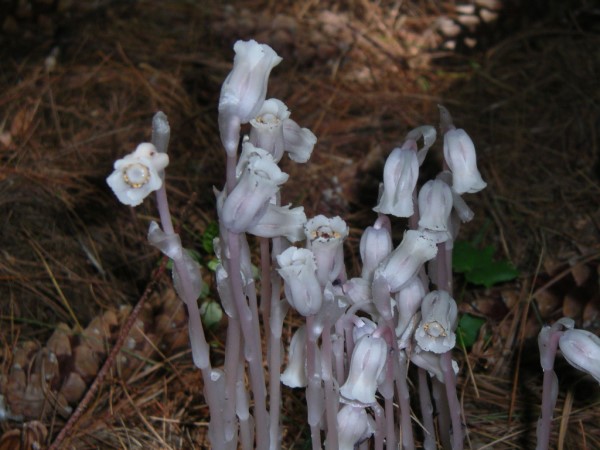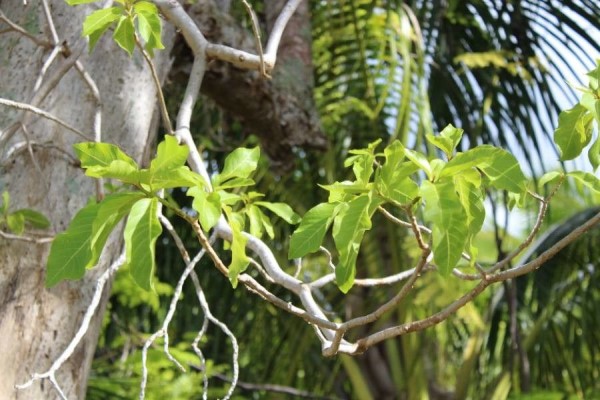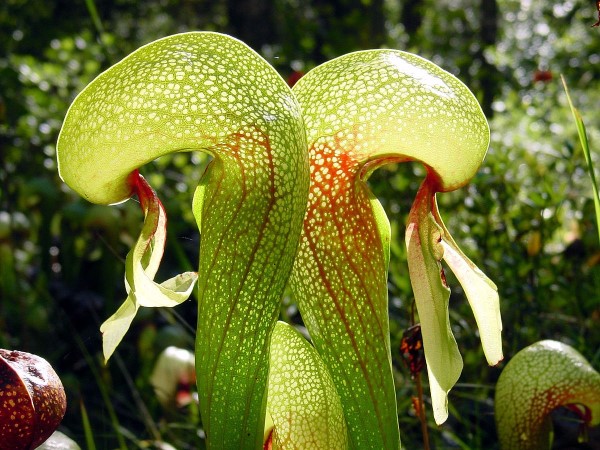While the worlds of haunts and herbs don’t often cross paths, every once in a while, there’s a plant so macabre that it’s a monster in its own right. From parasites to bird murder, there are plenty of nefarious characters in the world of botany, but look at me getting ahead of myself. Grab a spot around the hypothetical campfire, and I’ll set the scene.
The Leech
The ghost pipe is everything a plant shouldn’t be. Its haunting translucent white color is a devastating contrast to the lush green forest it calls home. A mysterious figure, the lack of pigment suggests that it must not contain any chlorophyll at all. Most plants would die if they couldn’t photosynthesize, but why sustain yourself when you can just thieve resources from something else?3
Ghost pipes aren’t easy to come by, but they’re native to much of the United States and Canada. Although they certainly don’t look the part, they’re perennial wildflowers that bear one drearily drooping flower per stem.3


While some other parasitic plants will still photosynthesize, the ghost pipe doesn’t, relying completely on other sources for food. Instead, it has a short root system that contains fungi. This fungus collects sugar from the roots of conifers, which is normal symbiotic behavior between mycorrhizal fungi and trees. The ghost pipe is the unwelcome third wheel, promptly taking all of the gifted resources.4 Because of this, the ghost pipe is considered mycotrophic, a parasite to fungi.2
The Killer
Each fruiting season, hundreds, if not thousands, of Indo-Pacific seabirds meet their demise in a mess of sticky seeds. While It’s certainly morbid, birdcatcher trees don’t have a conscious to care. The seeded fruit that the tree produces is treacherously resinous and adheres easily to bird feathers. When they accumulate, the birds can no longer fly or find food, causing mass mortality.5


While birds are the primary victim of the birdcatcher tree, even tree snakes have reportedly succumbed to the sticky seeds. Sure, the animals help disperse the seeds, but why are the methods so fatal? We don’t really know. While a growing seed benefits from extra nutrition, it’s not required for successful germination. Still, there are inherent benefits to all that extra animal matter fertilizing the soil despite the morbidity.5
The Carnivore
Finally, is the cobra lily, a plant that shares more than just its appearance with snakes. A member of the pitcher plant family, it’s a carnivorous plant that ensnares its prey using a tricky pitfall trap.
Unassuming insects and small animals are attracted to nectar glands inside of the plant. Hoping for a sweet snack, they never expect the quick drop into the fluid on the bottom of the pitcher. A proper trickster, the cobra lily even has transparent areas meant to look like escape routes to distract prey from finding a viable escape route. Eventually, bacteria will break down the prey for absorption by the plant.1


Unlike the ghost pipe, the cobra lily still does photosynthesize. The motive for its killing is that there aren’t enough nutrients available in the soil it grows in. Unfortunately, there are no gummy multivitamins for plants, so the cobra lily has to get creative to supplement its diet.1
While these are just a few examples, there are so many more creepy carnivores and pompous parasites to sink your teeth into! The world of botany is full of surprises, so pick up a book or do a quick search to continue your exploration. Happy haunting!
Sources
- “Cobra Plant.” Encyclopædia Britannica, Encyclopædia Britannica, inc., 23 Jan. 2015, www.britannica.com/plant/cobra-plant.
- “Monotropa Uniflora – One-Flowered Indian-Pipe.” Native Plant Trust: Go Botany, gobotany.nativeplanttrust.org/species/monotropa/uniflora/. Accessed 10 Sept. 2023.
- “Monotropa Uniflora.” USDA, www.fs.usda.gov/wildflowers/beauty/mycotrophic/monotropa_uniflora.shtml. Accessed 10 Sept. 2023.
- “Montropa Uniflora.” Botanical Society of America, cms.botany.org/home/resources/parasitic-plants/monotropa-uniflora.html. Accessed 10 Sept. 2023.
- Walker, T. A., M. Y. Chaloupka, and B. R. King. “Pisonia islands of the Great Barrier Reef.” Atoll Res. Bull 350 (1991): 1-23.











